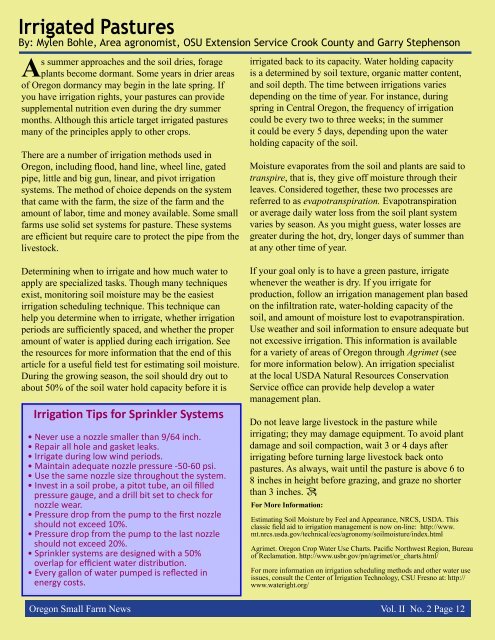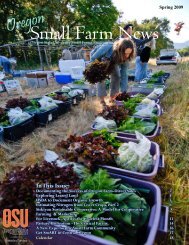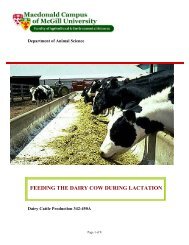Small Farm News - Oregon Small Farms - Oregon State University
Small Farm News - Oregon Small Farms - Oregon State University
Small Farm News - Oregon Small Farms - Oregon State University
Create successful ePaper yourself
Turn your PDF publications into a flip-book with our unique Google optimized e-Paper software.
Irrigated Pastures<br />
By: Mylen Bohle, Area agronomist, OSU Extension Service Crook County and Garry Stephenson<br />
As summer approaches and the soil dries, forage<br />
plants become dormant. Some years in drier areas<br />
of <strong>Oregon</strong> dormancy may begin in the late spring. If<br />
you have irrigation rights, your pastures can provide<br />
supplemental nutrition even during the dry summer<br />
months. Although this article target irrigated pastures<br />
many of the principles apply to other crops.<br />
There are a number of irrigation methods used in<br />
<strong>Oregon</strong>, including flood, hand line, wheel line, gated<br />
pipe, little and big gun, linear, and pivot irrigation<br />
systems. The method of choice depends on the system<br />
that came with the farm, the size of the farm and the<br />
amount of labor, time and money available. Some small<br />
farms use solid set systems for pasture. These systems<br />
are efficient but require care to protect the pipe from the<br />
livestock.<br />
irrigated back to its capacity. Water holding capacity<br />
is a determined by soil texture, organic matter content,<br />
and soil depth. The time between irrigations varies<br />
depending on the time of year. For instance, during<br />
spring in Central <strong>Oregon</strong>, the frequency of irrigation<br />
could be every two to three weeks; in the summer<br />
it could be every 5 days, depending upon the water<br />
holding capacity of the soil.<br />
Moisture evaporates from the soil and plants are said to<br />
transpire, that is, they give off moisture through their<br />
leaves. Considered together, these two processes are<br />
referred to as evapotranspiration. Evapotranspiration<br />
or average daily water loss from the soil plant system<br />
varies by season. As you might guess, water losses are<br />
greater during the hot, dry, longer days of summer than<br />
at any other time of year.<br />
Determining when to irrigate and how much water to<br />
apply are specialized tasks. Though many techniques<br />
exist, monitoring soil moisture may be the easiest<br />
irrigation scheduling technique. This technique can<br />
help you determine when to irrigate, whether irrigation<br />
periods are sufficiently spaced, and whether the proper<br />
amount of water is applied during each irrigation. See<br />
the resources for more information that the end of this<br />
article for a useful field test for estimating soil moisture.<br />
During the growing season, the soil should dry out to<br />
about 50% of the soil water hold capacity before it is<br />
Irrigation Tips for Sprinkler Systems<br />
• Never use a nozzle smaller than 9/64 inch.<br />
• Repair all hole and gasket leaks.<br />
• Irrigate during low wind periods.<br />
• Maintain adequate nozzle pressure -50-60 psi.<br />
• Use the same nozzle size throughout the system.<br />
• Invest in a soil probe, a pitot tube, an oil filled<br />
pressure gauge, and a drill bit set to check for<br />
nozzle wear.<br />
• Pressure drop from the pump to the first nozzle<br />
should not exceed 10%.<br />
• Pressure drop from the pump to the last nozzle<br />
should not exceed 20%.<br />
• Sprinkler systems are designed with a 50%<br />
overlap for efficient water distribution.<br />
• Every gallon of water pumped is reflected in<br />
energy costs.<br />
If your goal only is to have a green pasture, irrigate<br />
whenever the weather is dry. If you irrigate for<br />
production, follow an irrigation management plan based<br />
on the infiltration rate, water-holding capacity of the<br />
soil, and amount of moisture lost to evapotranspiration.<br />
Use weather and soil information to ensure adequate but<br />
not excessive irrigation. This information is available<br />
for a variety of areas of <strong>Oregon</strong> through Agrimet (see<br />
for more information below). An irrigation specialist<br />
at the local USDA Natural Resources Conservation<br />
Service office can provide help develop a water<br />
management plan.<br />
Do not leave large livestock in the pasture while<br />
irrigating; they may damage equipment. To avoid plant<br />
damage and soil compaction, wait 3 or 4 days after<br />
irrigating before turning large livestock back onto<br />
pastures. As always, wait until the pasture is above 6 to<br />
8 inches in height before grazing, and graze no shorter<br />
than 3 inches.<br />
For More Information:<br />
Estimating Soil Moisture by Feel and Appearance, NRCS, USDA. This<br />
classic field aid to irrigation management is now on-line: http://www.<br />
mt.nrcs.usda.gov/technical/ecs/agronomy/soilmoisture/index.html<br />
Agrimet. <strong>Oregon</strong> Crop Water Use Charts. Pacific Northwest Region, Bureau<br />
of Reclamation. http://www.usbr.gov/pn/agrimet/or_charts.html/<br />
For more information on irrigation scheduling methods and other water use<br />
issues, consult the Center of Irrigation Technology, CSU Fresno at: http://<br />
www.wateright.org/<br />
<strong>Oregon</strong> <strong>Small</strong> <strong>Farm</strong> <strong>News</strong> Vol. II No. 2 Page 12















